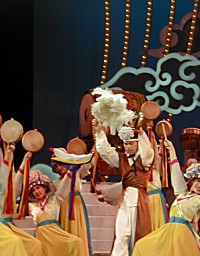
Korean cultural programme at the opening ceremony
performed by the Sheraton Walker Hill Hotel entertainment group.
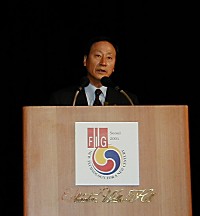
President Kim Jaeyoung, Korea
Confederation of Surveyors opened the FIG working week in Seoul.
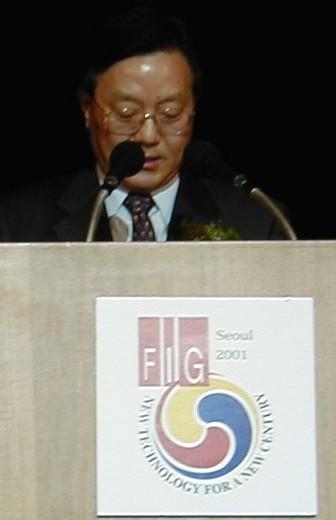
Vice Minister of the Ministry of Government
Administration and Home Affairs giving his welcome greetings and
inviting FIG to Korea in 2010.
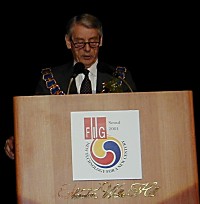
President Robert W. Foster giving his
keynote address at the opening ceremony.
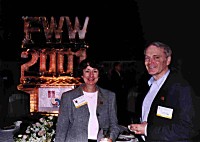
Mary Clawson, Congress Director FIG 2002
and Charles Challstrom, Vice President of FIG at the welcome
reception.
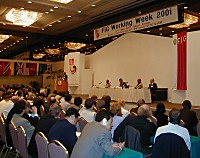
The plenary session on the visions of surveying
attracted full hall of participants like all technical sessions.
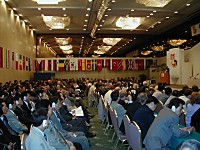
The Korean organisers provided interpretation
between English and Korean for the plenary sessions and commission 7
sessions. The opening ceremony was also translated into Japanese.

The General Assembly adopted unanimously the new
statutes and internal rules for the Federation.
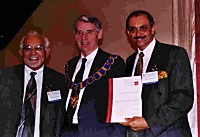
President Robert W. Foster (in the middle)
together with Angel Villalba Ortiz (right) and Israel
Otero Rosario from CIAPR, Puerto Rico.
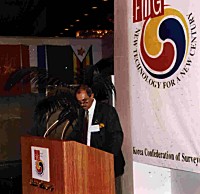
President Angel Villalba Ortiz giving his speech
after CIAPR was admitted the membership of FIG.
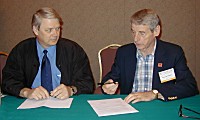
President Jens Bruun Andersen, DdL and
President Robert Foster signed an agreement that guarantees the
permanent office in Copenhagen after the first five years.
|
The International Federation of Surveyors (FIG) organised
its 24th General Assembly and technical conference in Seoul, Korea 6-11
May 2001. This event is called FIG annual Working Week turned to be the
largest ever FIG annual gathering between the four-yearly congresses. It
was also among the most successful both by professional and social
indicators thanks to the effective Korean organisers and the famous Korean
hospitality. With almost 1,000 participants from over 50 countries and
with more than 30 technical sessions and workshops, in which about 150
papers were presented, this year's working week was more like a congress.
Similar to all FIG working weeks there was a range of technical tours,
during which the participants were able to learn about the Korean cadastre
and latest technology. The social programme was flavoured with the Korean
food and culture. The technical exhibition with 25 exhibitors gave a good
opportunity to see the development on surveying in Korea and in North East
Asia.
The conference was organised by the Korea Confederation of
Surveyors which was established by Korea Cadastral Survey
Corporation (KCSC) and the Korean Association of Surveying and
Mapping (KASM) in 1981 and which joined FIG in 1983. This year's
meeting was generously sponsored by both KCSC and KASM and the
Ministry of Government Administration and Home Affairs. The FIG
working week was also part of the Visit Korea Year 2001 campaign.
The opening ceremony with Korean cultural programme attracted
about 700 delegates. The opening address was given by President
Kim Jaeyoung, Korea Conferderation of Surveyors and the welcome
address was given by President Robert W. Foster, FIG.
The technical conference titled "Technology for a New Century"
consisted of 29 technical sessions running parallel for three days.
The themes of the conference covered all nine technical commissions
of FIG. The two plenary sessions focussed on the visions on
surveying, including e.g. presentation on the relationship between
surveying and politics given by Prof. Holger Magel the
incoming President of FIG. The other important input to this session
was the presentation on the mutual recognition of professional
qualifications. This paper prepared by Prof. Stig Enemark and
Dr. Frances Plimmer explained the concept tailored for
surveying profession which FIG will launch in 2002. The two
remaining papers focussed on topics central for the whole
conference, namely Korean experiences, in this session an overview
on the visions on the Korean cadastre presented by Lee Myounwoo,
Vice President of KCSC, and location based services and personal
navigation in mobile information society given by Antti Rainio
from Finland.
The second plenary session gave insight views on the broad
international co-operation that FIG is having with the United
Nations and its agencies and with other international partners. At
this conference the partners were represented by Jan Meeuwissen
from UNCHS (Habitat), who made a presentation on establishing land
administration in post-conflict regions, in this case in East Timor
and Willi Zimmermann, Germany/Cambodia, who made his
contribution from the perspective of a national aid programme (the
German Agency for Technical Co-operation).
The co-operation between FIG and the UN will continue already
this autumn when FIG together with the United Nations Centre for
Human Settlements (Habitat) and the Institute of Surveyors of Kenya
organises an International Conference on Spatial Information for
Sustainable Development in Nairobi, Kenya, October 2-5, 2001. FIG
will together with the World Bank and PC IDEA further organise an
inter regional workshop to determine policies and programs for
education, training and professional capacity building in Mexico in
September 2002.
In the technical conference there was extremely strong input from
the commission on cadastre and land administration, commission on
spatial information management and commission on positioning and
measurement. Themes included e.g. cadastral systems and sustainable
development, legal and technical trends in cadastre including 3D
cadastre, spatial information infrastructures, permanent GPS
networks and facility management systems. In addition to these
technical themes topics like business practices and educational
issues were highlighted, especially virtual academy, international
surveying curricula and education of valuers.
Further a series of workshops were organised. These focused on
several reports and FIG guidelines that will be prepared for the
approval of the next General Assembly during the FIG Congress in
Washington. E.g. Commission on positioning and measurement organised
three workshops on the FIG guidelines for check, maintenance and
calibration of survey instruments. Another hot topic was
standardisation. The special session on standards in surveying
(including ISO standards) was followed by a workshop in which the
FIG guide on standardisation was discussed.
It was delightful that both participation and number of papers
from the North East Asian countries was higher than ever. Special
thanks belong to the Korean presentations that added the local and
regional perspective to all themes discussed. Furthermore
participation not only from Japan and China but also from other
Asian countries like the Mekong region (Cambodia and Vietnam) was
most encouraging. The Korean organisers introduced a new concept of
regional meetings by organising an Asian night for the participants
from Asia. This special meeting attracted almost 40 representatives.
The working week in Seoul was historical for FIG in many ways. At
the same time when it was the biggest working week in the FIG
history it was a turning point in the governance of the Federation.
The General Assembly adopted unanimously on the last day of the
conference the new statutes and internal rules for FIG. This means
that FIG is now on a way towards a fully democratic organisation. In
the future the members of the Council will be elected by the General
Assembly so that the first Vice President will be elected by the
General Assembly in 2002 and that the new structure is in full
operation in 2007. At that time all members of the Council will
represent not only different countries but also, hopefully,
different continents. This is a big step in the process of changing
the FIG to an truly international surveying organisation. The
renewal of the governance will continue with the review of the
Commission structure. The first draft was discussed during the
breakout sessions in Seoul.
The General Assembly further adopted two important reports namely
FIG Agenda 21 which is the FIG response to the implementation of
Agenda 21 adopted in Rio de Janeiro 1991 and to the Habitat Agenda
adopted in Istanbul in 1996. The second report is the FIG Guidelines
on Women's Access to Land, which is a part of the FIG contribution
to the discussion on promoting the security of tenure. These
guidelines prepared by FIG commission on land management highlight
the importance of equal access to land for the women as well as
gives practical guidelines to those working with land administration
projects in developing countries.
The General Assembly further admitted six new member associations
to the Federation. These come from Armenia, Finland, Mongolia,
Morocco and Puerto Rico. The total number of FIG member associations
is 85 representing 72 countries after the meeting in Seoul. To help
the member associations from the developing countries the General
Assembly decided to change the membership fee structure so that the
members from the poorest countries will pay only 50 per cent of the
standard membership fee from year 2003. In addition a new affiliate
member was admitted from Cambodia and the number of academic members
raised to 37 (from 25 countries).
The number of corporate members in FIG has raised quickly during
the current US Council. The campaign and new benefits offered to the
corporate members have increased the total number already to 17
which is an increase by 7 since the General Assembly in Prague, May
2000.
The General Assembly further endorsed the statutes of the FIG
Foundation that was established by transferring the former Education
Foundation from Australia to the FIG office in Denmark. The new
Board of Directors has already started a fundraising campaign to
raise funds to help the developing countries in educational issues.
Next year FIG will meet at the XXII Congress in Washington, DC
April 19-26, 2002. The organisers expect even 5,000 participants to
this congress because it will be held in conjunction with the
national congresses of the American Congress on Surveying and
Mapping (ACSM) and the Imaging & Geospatial Information Society
(ASPRS).
The papers of the FIG working week 2001 and the technical
conference are available on the FIG home page:
http://www.fig.net. Information about the FIG Congress 2002 can
be found at http://www.fig2002.com. |

